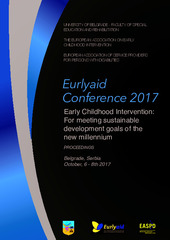Приказ основних података о документу
Hronična tuga kod roditelja dece sa smetnjama u razvoju
Chronic sorrow in parents of disabled children
| dc.contributor | Mirko Filipović | |
| dc.contributor | Branislav Brojčin | |
| dc.creator | Stanimirović, Dragana | |
| dc.creator | Mijatović, Luka | |
| dc.creator | Korićanac, Irena | |
| dc.date.accessioned | 2021-06-17T13:35:19Z | |
| dc.date.available | 2021-06-17T13:35:19Z | |
| dc.date.issued | 2017 | |
| dc.identifier.isbn | 978-86-6203-101-3 | |
| dc.identifier.uri | http://rfasper.fasper.bg.ac.rs/handle/123456789/2719 | |
| dc.description.abstract | Hronična tuga se odnosi na jedinstvenu emocionalnu reakciju koja se javlja kada je gubitak kontinuirano prisutan u životu neke osobe. Ovaj pojam se najpre vezivao za gubitke koji se tiču zdravstvenog stanja drugih. Poslednjih godina se primenjuje i na doživljaje patnje u vezi sa sopstvenim zdravljem. Roditelji dece sa smetnjama u razvoju se suočavaju sa snažnim osećanjem bola nakon saznanja koja se tiču dijagnoze deteta. Bol ne prestaje usled toga što se proces tugovanja ne završava. Jedinstvenost procesa hroničnog tugovanja jeste upravo u tome što vremenom ne gubi na intenzitetu, već se održava, a čak i pojačava tokom brojnih situacija (nedovoljno responzivno osoblje, promena lekara, polazak deteta u školu, iskustva stigmatizacije i dr.) koje mogu reaktivirati stanje tuge. Drugi aspekt jedinstvenosti ove pojave ogleda se u postojanju perioda stabilnosti i adaptacije, tokom kojih roditelji doživljavaju i pozitivne emocije u vezi sa stanjem svog deteta. Ciklični karakter procesa hronične tuge često dovodi do kumulativnog efekta tuge, naročito ako je povišena vulnerabilnost roditelja praćena nedostatkom razumevanja i adekvatne podrške od strane užeg socijalnog okruženja i zdravstvenog osoblja. Stanje hronične tuge se razlikuje od depresivnih i anksioznih poremećaja i od izuzetne je važnosti da na adekvatan način bude prepoznato, kako bi se smanjila mogućnost dalje patologizacije i stigmatizacije porodice deteta sa smetnjama. Tretman ovog specifičnog oblika tugovanja se pre svega odnosi na pomoć roditeljima da usvoje što adekvatnije strategije prevladavanja stresa. Redefinisanje situacije i prihvatanje neizvesnosti u pogledu budućnosti pružaju mogućnost da se oslobode i iskoriste zdravi porodični kapaciteti. Pomeranjem fokusa sa slabosti porodičnog sistema na njegove snage se, u skladu sa modelom izazova, jačaju porodične rezilijence i utire put uspešnijem prevladavanju narednih stresnih događaja. | |
| dc.description.abstract | Research subject: Chronic sorrow refers to a specific emotional response that occurs when the loss is continuously present in a person’s life. This term was primarily referred to losses related to health conditions of others. In recent years, it also applies to the experiences of suffering linked to one’s own health. Method: Based on the review of theoretical and empirical researches, the main questions of chronic sorrow in parents of disabled children are highlighted. Results: Parents of children with disabilities are faced with a strong sense of pain after getting the information concerning the child’s diagnosis. The pain does not stop because the grieving process never reaches closure. The uniqueness of the process of chronic sorrow lies in the fact that it does not lose its intensity over time; rather, the intensity of grief maintains the same or even increases during numerous situations (insufficiently responsive staff, changing doctors, starting school, experiences of stigmatization, etc.) which can reactivate the state of sorrow. Another aspect of the uniqueness of this phenomenon is reflected in the existence of periods of stability and adaptation, during which the parents are experiencing positive emotions about their child’s condition. The cyclic nature of the process of chronic sorrow often leads to a cumulative effect of sadness, especially when increased vulnerability of parents is accompanied by a lack of understanding and adequate support from the narrower social environment and health personnel. Conclusion: Condition of chronic sorrow differs from depression and anxiety disorders. In order to reduce the possibility of further stigmatization and pathologisation of families of children with disabilities, it is very important to adequately detect this state. The treatment of this specific form of grieving primarily refers to helping parents to adopt appropriate coping strategies. Redefining the situation and acceptance of uncertainty about the future provide an opportunity for releasing and using healthy family capacities. Shifting the focus from weaknesses of the family system to its strengths, according to the Challenge model, empowers family resilience and enables more successful coping with future stressful events. | |
| dc.language | sr | |
| dc.publisher | University of Belgrade, Faculty of Special Education and Rehabilitation, Serbia / Univerzitet u Beogradu – Fakultet za specijalnu edukaciju i rehabilitaciju | |
| dc.rights | openAccess | |
| dc.rights.uri | https://creativecommons.org/licenses/by-sa/4.0/ | |
| dc.source | Zbornik radova | |
| dc.source | Proceedings- Eurlyaid Conference 2017 „ Early Childhood Intervention: For meeting sustainable development goals of the new millennium “, Beograd, Srbija, 06–08. 10.2017. | |
| dc.subject | hronična tuga | |
| dc.subject | dete sa smetnjama u razvoju | |
| dc.subject | roditelji | |
| dc.subject | prevladavanje stresa | |
| dc.subject | chronic sorrow | |
| dc.subject | child with disability | |
| dc.subject | parents | |
| dc.subject | coping with stress | |
| dc.title | Hronična tuga kod roditelja dece sa smetnjama u razvoju | sr |
| dc.title | Chronic sorrow in parents of disabled children | |
| dc.type | conferenceObject | |
| dc.rights.license | BY-SA | |
| dc.citation.epage | 281 | |
| dc.citation.other | : 275-281 | |
| dc.citation.spage | 275 | |
| dc.description.other | Eurlyaid Conference 2017 - Early Childhood Intervention: For meeting sustainable development goals of the new millennium | |
| dc.identifier.fulltext | http://rfasper.fasper.bg.ac.rs/bitstream/id/6158/Untitled34.pdf | |
| dc.identifier.rcub | https://hdl.handle.net/21.15107/rcub_rfasper_2719 | |
| dc.type.version | publishedVersion |


